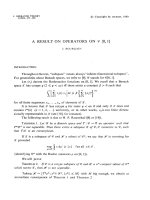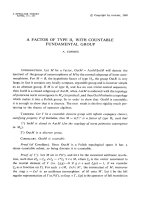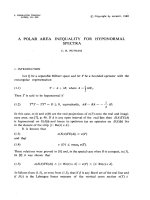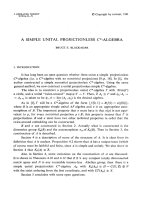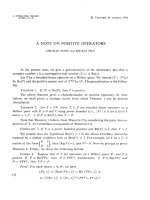Báo cáo toán học: " A Stochastic EOQ Policy of Cold-Drink-For a Retailer" ppsx
Bạn đang xem bản rút gọn của tài liệu. Xem và tải ngay bản đầy đủ của tài liệu tại đây (93.81 KB, 6 trang )
Vietnam Journal of Mathematics 33:4 (2005) 437–442
A Stochastic EOQ Policy
of Cold-Drink-For a Retailer
Shib Sankar Sana
1
and Kripasindhu Chaudhuri
2
1
Departme nt of Math., Bhangar Mahavidyalaya University of Calcutta
Viil. +P.O.+ P. S Bhangar, Dist 24PGS(South) West Bengal, India
2
Department of Mathematics Jadavpur Universi ty,
Calcutta -700032 West Bengal, India
Received June 22, 2005
Abstract. This paper extends a stochastic EOQ (economic order quantity)model
both for discrete and continuous distribution of demands of cold-drink. A general
characterization of the optimal inventory policy is developed analytically. An optimal
solution is obtained with proper numerical illustration.
1. Introduction
A well-known stochastic extension of the classical EOQ (economic order quan-
tity) model bases the re-order decision or the stock level (see Hadley and Whitin
[4], Wagner [13]). Models of storage systems with stochastic supply and demand
have been widely analysed in the models of Faddy [3], Harrison and Resnick [5],
Miller [8], Moran [9], Pliska [10], Puterman [11], Meyer, Rothkopf and Smith [7],
Teisberg [12], Chao and Manne [1], Hogan [6] and Devarangan and Weiner [2].
In this paper, an optimal inventory policy is characterised by conditions: (a)
demand rate is stochastic that depends upon temperature as random variable;
(b) supply rate is instanteneously infinite and order is placed in the begining of
the cycle; (c) inventory cost is a linear function of temperature.
2. Fundamental Assumptions and Notations
1. Model is developed on single-item products.
438 Shib Sankar Sana and Kripasindhu Chaudhuri
2. Lead time is negligible.
3. Demand is uniform over the period and a function of temperature that
follows a probability distributions.
4. Production rate is instanteneously infinite.
5. Reorder-time is fixed and known. Thus the set-up cost is not included in
the total cost.
Let the holding cost per item per unit time be C
h
, the shortage cost per item
per unit time be C
s
, the inventory level be Q of item, r is the demand over the
period, T is the cycle length.
3. The Model
In this model, we consider demand rate of the product (r) and inventory holding
cost per item per unit time (C
h
)are:
r = aτ
and
C
h
= C
1
+ C
2
(τ − μ).
where,
a =
dr
dτ
(≥ 0) = marginal response of cold-drink consumption to a change in
τ(temperature)
C
1
= opportunity cost of money tied up in inventory.
C
2
= rate of change of inventory cost with respect to temperature.
μ = optimum temperature for a buyer, according to their demand. Generally μ
is 5
◦
C.
Now, the governing equations are as follows:
Case 1. When Shortage does not occur
dQ
dt
= −
r
T
, 0 ≤ t ≤ T (1)
with Q(0) = Q
0
.
From Eq. (1), we have
Q(t)=Q
0
−
r
T
t, 0 ≤ t ≤ T.
Here Q(T ) ≥ 0 ⇒ Q
0
−
r
T
T ≥ 0 ⇒ Q
0
≥ r. Therefore, the inventory is
T
0
(Q
0
−
r
T
t)dt =(Q
0
−
r
2
)T, for r ≤ Q
0
.
Case 2. When Shortage occurs:
dQ
dt
= −
r
T
, 0 ≤ t ≤ t
1
(2)
with Q(0) = Q
0
,andQ(t
1
)=0,
A Stochastic EOQ Policy of Cold-Drink -For a Retailer 439
and
dQ
dt
= −
r
T
,t
1
≤ t ≤ T (3)
with Q(T ) < 0.
From Eq. (2), we have
Q(t)=Q
0
−
r
T
t, 0 ≤ t ≤ t
1
.
Now Q(t
1
)=0⇒ t
1
=
Q
0
T
r
. The Eq. (3) gives us
Q(t)=−
r
T
(t − t
1
),t
1
≤ t ≤ T.
So Q(T ) < 0 ⇒−
r
T
(T − t
1
) < 0 ⇒ T>t
1
⇒ T>
Q
0
T
r
⇒ Q
0
<r. Therefore,
the inventory during (0,t
1
)is
t
1
0
(Q
0
−
r
T
t)dt = Q
0
t
1
−
r
2T
t
2
1
=
1
2
Q
2
0
r
T.
The shortage during (t
1
,T)is
T
t
1
−Q(t)dt =
r
2T
(T − t
1
)
2
=
1
2
rT
1 −
Q
0
r
)
2
,r>Q
0
.
Since, Q
0
≥ r ⇒ Q
0
≥ aτ ⇒ τ ≤
1
a
Q
0
= τ
∗
(say). i.e., Q
0
= aτ
∗
.Also,
Q
0
<r⇒ τ>τ
∗
.
Case I. Uniform demand and discrete units.
τ is random variable with probability p(τ) such that
∞
τ =τ
0
p(τ)=1 and
p(τ) ≥ 0.
Therefore the expected average cost is
Eac(τ
∗
)=
1
T
τ
∗
τ =τ
0
C
h
Q
0
−
r
2
Tp(τ)+
1
2
∞
τ =τ
∗
+1
C
h
Q
2
0
r
p(τ)T
+
1
2
C
s
∞
τ =τ
∗
+1
rT
1 −
Q
0
r
2
p(τ)
=
τ
∗
τ =τ
0
(C
1
− C
2
μ + C
2
τ)a
τ
∗
−
τ
2
p(τ)
+
1
2
∞
τ =τ
∗
+1
a(C
1
− C
2
μ + C
2
τ)τ
∗2
p(τ)
τ
+
1
2
C
s
∞
τ =τ
∗
+1
aτ
1 −
τ
∗
τ
2
p(τ)
440 Shib Sankar Sana and Kripasindhu Chaudhuri
Now,
Eac(τ
∗
+1)=Eac(τ
∗
)+(C
1
− C
2
μ + C
s
)a
τ
∗
τ =τ
0
p(τ)+
τ
∗
+
1
2
∞
τ
∗
+1
p(τ)
τ
− C
s
+ aC
2
τ
∗
τ =τ
0
τp(τ)+
τ
∗
+
1
2
∞
τ =τ
∗
+1
p(τ)
.
In order to find the optimum value of Q
∗
0
i.e., τ
∗
so as to minimize Eac(τ
∗
), the
following conditions must hold: Eac(τ
∗
+1) >Eac(τ
∗
)andEac(τ
∗
− 1) >
Eac(τ
∗
) i.e., Eac(τ
∗
+1)− Eac(τ
∗
) > 0andEac(τ
∗
− 1) − Eac(τ
∗
) > 0.
Now, Eac(τ
∗
+1)− Eac(τ
∗
) > 0 implies
(τ
∗
)+
C
2
C
1
− C
2
μ + C
s
(τ
∗
) >
C
s
C
1
− C
2
μ + C
s
,
where
(τ
∗
)=
τ
∗
τ =τ
0
p(τ)+(τ
∗
+
1
2
)
∞
τ
∗
+1
p(τ)
τ
(τ
∗
)=
τ
∗
τ =τ
0
τp(τ)+(τ
∗
+
1
2
)
∞
τ =τ
∗
+1
p(τ).
Similarly Eac(τ
∗
− 1) − Eac(τ
∗
) > 0 implies
(τ
∗
− 1) +
C
2
C
1
− C
2
μ + C
s
(τ
∗
− 1) <
C
s
C
1
− C
2
μ + C
s
.
Therefore for minimum value of Eac(τ
∗
), the following condition must be satis-
fied
(τ
∗
)+
C
2
C
1
− C
2
μ + C
s
(τ
∗
)
>
C
s
C
1
− C
2
μ + C
s
> (τ
∗
− 1)+
C
2
C
1
− C
2
μ + C
s
(τ
∗
− 1) (4)
Case II. Uniform demand and continuous units.
When uncertain demand is estimated as a continuous random variable, the cost
equation of the inventory involves integrals instead of summation signs. The
discrete point probabilities p(τ) are replaced by the probability differential f(τ)
for small interval. In this case
∞
0
f(τ) dτ =1andf(τ) ≥ 0. Proceeding
exactly in the same manner as in Case I, The total expected average cost during
period (0,T)is
A Stochastic EOQ Policy of Cold-Drink -For a Retailer 441
Eac(τ
∗
)=aτ
∗
τ
∗
τ =τ
0
(C
1
− C
2
μ + C
2
τ)f(τ)dτ −
a
2
τ
∗
τ
0
(C
1
− C
2
μ + C
2
τ)τf(τ)dτ
+
a
2
τ
∗2
∞
τ
∗
(C
1
− C
2
μ + C
2
τ)
f(τ)
τ
dτ +
a
2
C
s
∞
τ
∗
(τ − τ
∗
)
2
f(τ)
τ
dτ
(5)
Now,
dEac(τ
∗
)
dτ
∗
= a
(C
1
− C
2
μ + C
s
)
τ
∗
τ
0
f(τ)dτ + τ
∗
∞
τ
∗
f(τ)
τ
dτ
+ C
2
τ
∗
τ
0
τf(τ)dτ + τ
∗
∞
τ
∗
f(τ)dτ
− C
s
(6)
and
d
2
Eac(τ
∗
)
dτ
∗2
= a
(C
1
− C
2
μ + C
s
)
∞
τ
∗
f(τ)
τ
dτ + C
2
∞
τ
∗
f(τ)dτ
> 0. (7)
For minimum value of Eac(τ
∗
),
dEac(τ
∗
)
dτ
∗
=0and
d
2
Eac(τ
∗
)
dτ
∗2
> 0mustbe
satisfied. The equation,
dEac(τ
∗
)
dτ
∗
= 0 being nonlinear can only be solved by
any numerical method (Bisection Method) for given parameter values.
4. Numerical Examples
Example 1. For discrete case:
In this case, we consider C
1
=0.135,C
2
=0.001,C
s
=5.0,μ=5.0,a=0.8
in appropriate units and also consider the probability of temperature in a week
such that
τ in
◦
C:35363738394041
p(τ) : 0.05 0.15 0.14 0.10 0.25 0.10 0.21
Then the optimal solution is τ
∗
=38
o
C i.e., Q
∗
= aτ
∗
=30.4 units.
Example 2. For continuous case:
We take the values of the parameters in appropriate units as follows:
f(τ)=0.04 − 0.0008τ, 0 ≤ τ ≤ 50
=0, elsewhere
442 Shib Sankar Sana and Kripasindhu Chaudhuri
C
1
=0.135,C
2
=0.001,C
s
=5.0 ,μ=5.0,a=0.8. Then the optimal solution
is: τ
∗
=29.30
◦
C i.e., Q
∗
= aτ
∗
=23.44 units.
5. Conclusion
From physical phenomenon, it is common belief that the consumption of cold
drinks depend upon temperature. Temperature is also random in character.
Generally the procurement cost of cold drinks is smaller than their selling price.
Consequently, supply of cold drinks to the retialer is sufficiently large. Inventory
holding cost is broken down into two components: (i) the first is the opportunity
cost of money tied up in inventory that is considered here as C
1
(ii)the2nd
is C
2
(τ − μ), where μ is optimum temperature for a buyer according to their
demand. Generally, μ is 5
◦
C. So the cost of declining temperature (τ − μ)has
a remarkable effect on the inventory cost. In reality, the discrete case is more
realistic than the continuous one. But we discuss both the cases. As far as
the authors are informed, no stochastic EOQ model of this type has yet been
discussed in the inventory literature.
References
1. H. Chao and A. S. Manne, It oil stock-piles and import reductions: A dynamic
programming approach, Opns. Res. 31 (1983) 632–651.
2. S. Devarangan and R. Weiner, Stockpile B ehavior as an International Game,
Harvard University, 1983.
3. M. J. Faddy, Optimal control of finite dams, Adv. Appl. Prob. 6 (1974) 689–710.
4. G. Hadly, and T. Whitin, Analysis of Inventory System. Prentice-Hall, Engle-
wood Cliffs, NJ, 1963.
5. J. M. Harrison and S. I. Resnick, The stationary distribution and first exit prob-
abilities of a storage process with general release rules, Math. Opns. Res. 1
(1976) 347–358.
6. W. W. Hogan, Oil stockpiling: help thy neighbor, Energy. J. 4 (1983) 49–71.
7. R. R. Meyer, M. H. Rothkopf, and S. A. Smith, Reliability and inventory in a
production-storage system, Mgmt. Sci. 25 (1979) 799–807.
8. R. G. Miller, Jr., Continuous time stochastic storage processes with random linear
inputs and outputs, J. Ma th. Mec h. 12 (1963) 275–291.
9. P. A. Moran, The Theory o f Storage, Metuen, London, 1959.
10. S. R. Pliska, A diffusion process model for the optimal operations of a reservoir
system, J. Appl. Prob. 12 (1975) 859–863.
11. M. L. Puterman, A diffusion process model for the optimal operations of a reser-
voir system, North-Holland/Times studies in the management service 1 (1975)
143–159.
12. T. J. Teisberg, A dynamic programming model of the U. S. strategic petroleum
reserve, Bell. J. Econ. 12 (1981) 526–546.
13. H. M. Wagner, Statistical Management of Inventory Systems, John Wiley & Sons,
1962.



